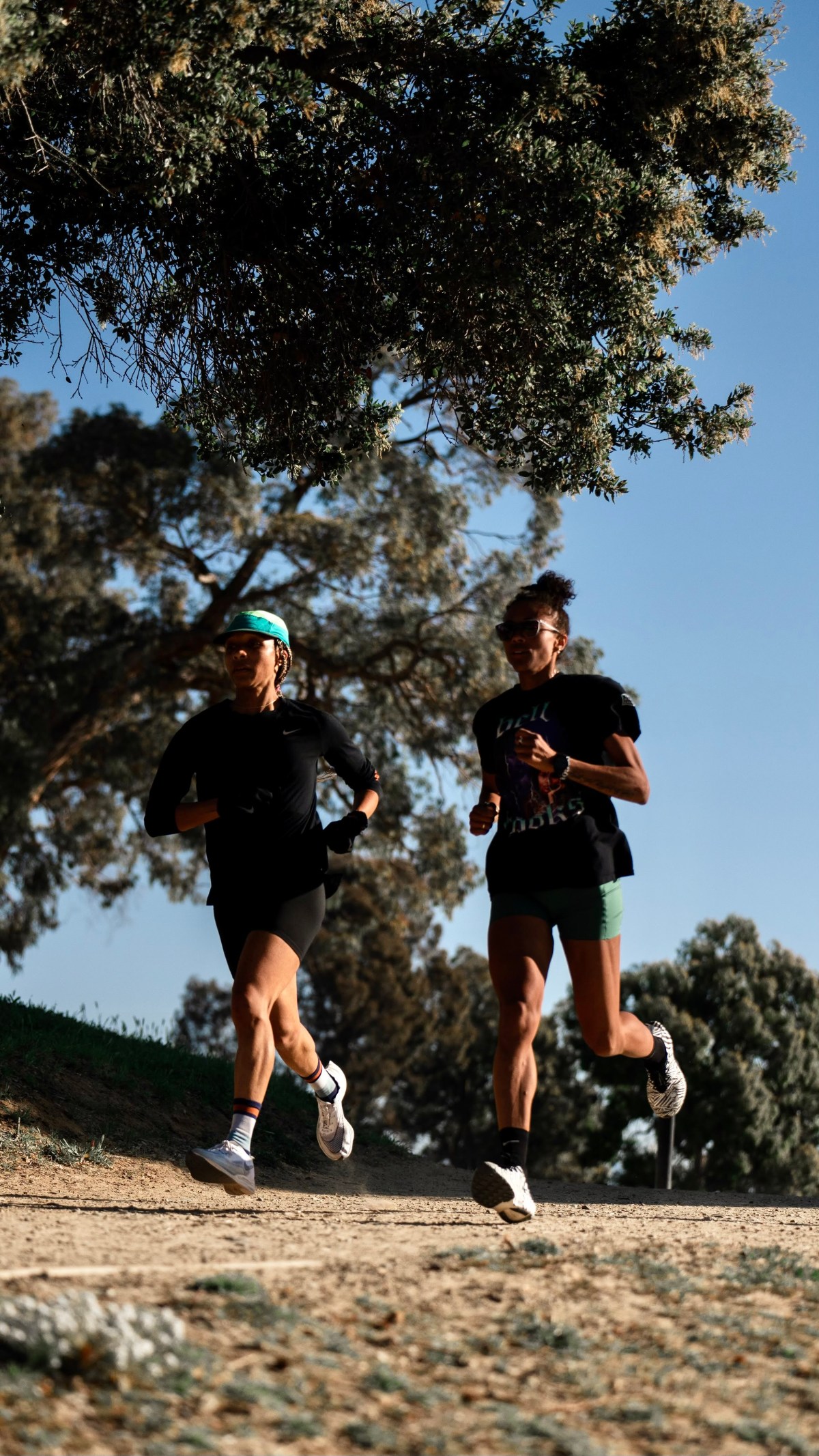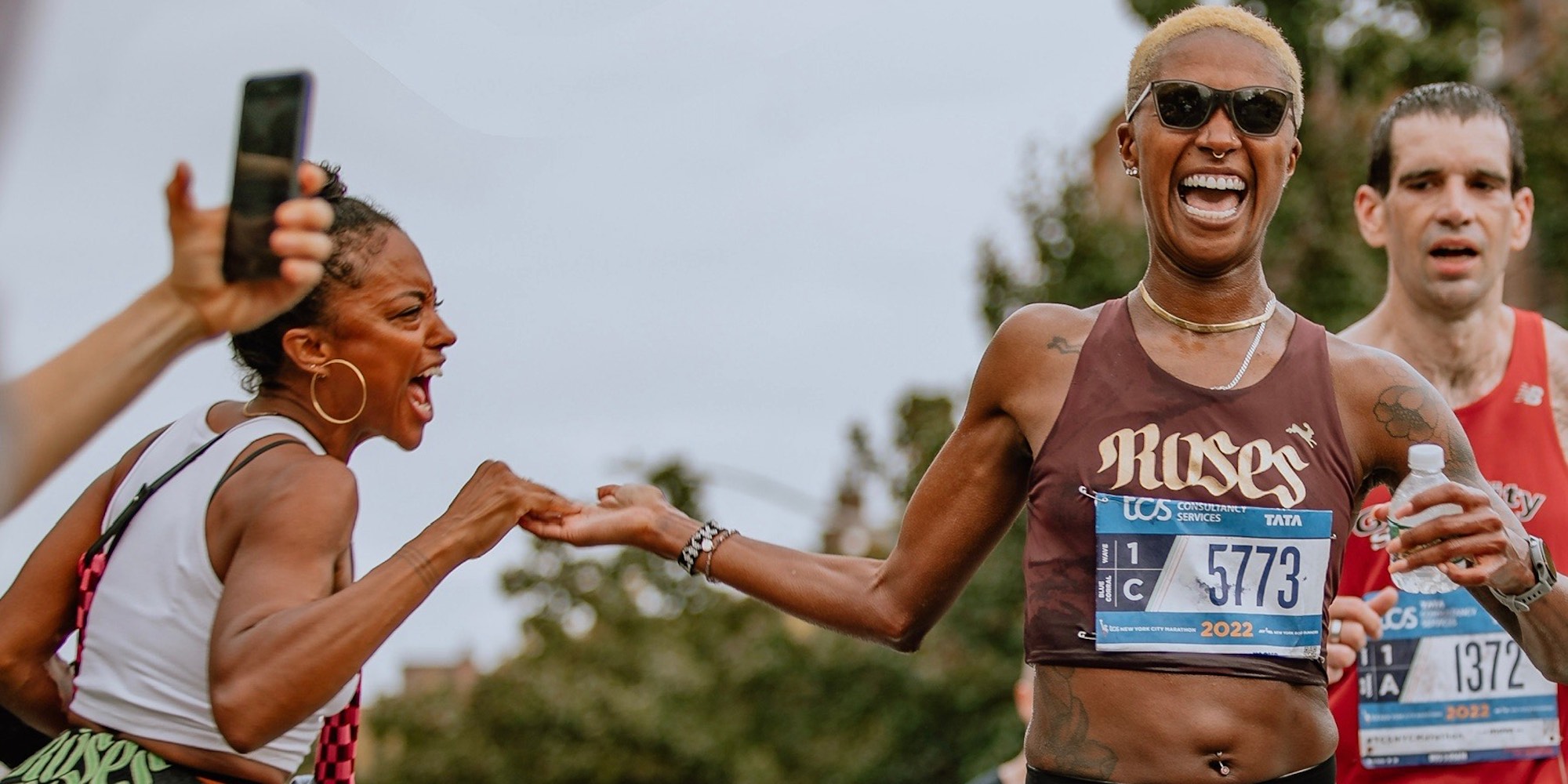Without new visions, we don’t know what to build, only what to knock down. We not only end up confused, rudderless, and cynical, but we forget that making a revolution is not a series of clever maneuvers and tactics, but a process that can and must transform us.
Robin D.G. Kelley, Freedom Dreams: The Black Radical Imagination
Days after racing the 2022 Berlin Marathon–now with enough space in the brain to think about all the other things that woo me beyond racing–I visit the temporary Bauhaus archive in Haus Hardenberg in West Berlin with a few teammates from Black Roses. Now regarded as one of the birthplaces of contemporary design, the Bauhaus was an art school founded by architect Walter Gropius that operated from 1919-1933. The school was intentionally interdisciplinary, requiring students to cross-pollinate their learnings from one discipline, like painting, with another, like architecture; the mixing and melding was itself a creative practice.
My teammate Toby and I, both feeling free because we had good races and now possess the time and space to play with ideas, make up a story about the German and Russian Expressionist artists (and close friends) Paul Klee and Wassily Kandinsky. We imagine them facilitating young architects and painters and sculptors through some wild, multifarious exercise that results in Marcel Breuer’s Wassily Chair —something we both covet now. We slowly walk ourselves along the timeline of the Bauhaus displayed on the wall, inspired by the possibilities of what schooling could be and how good an education like the one Bauhaus students received must have felt. Our imaginations are active and firing in multiple directions.
Here we are, riffing on ideas about running zines, how to visually communicate our coaches’ workouts using shapes, and the perfect shade of purple. After stewing in self-pity, longing for the schooling I felt cheated out of as a young adult, I return to running. Running is a creative practice. More specifically, in Black Roses, our school of running is contingent on creativity.
Running is old. Marathoning is old—its legend harkening back to 490 BC, and its inclusion in the modern Olympics taking place from the event’s origination in 1896. And ever since, people have been getting faster at the distance. Looking at metrics alone–including the huge improvements seen in amateur marathoning (the number of Olympic Trials Qualifiers for the marathon increased by over 50% over between the 2016 and 2020 Olympic Trials)–perhaps an alternative approach to running is not necessary for most people. Many runners are content with convention, including training that centers paces, heart rate and V02 max. Yet, I could not commit to this wild way of life–the commitments, sacrifices, satisfaction and heartbreak involved in running fast marathons –if raw numbers were all that mattered after a 15 x 1 kilometer workout on a dirt loop.
Instead, I’m interested in the ways running spills into and out of other disciplines, and I find inspiration in my own, informal kind of education. In writer Carina del Valle Schorske’s essay “Dancing Through New York in a Summer of Joy and Grief,” she describes the spectrum of feelings that surface through social dancing, which she experiences during a tour of parties across New York City in the summer of 2021. She takes note of “the pulse that precedes any choreography.”. Whatever is visibly happening between bodies in the party, there is something that precedes that. That pulse is what happens first, and it drives the movement. What is it that informs that pulse?
Black Roses was cofounded in 2013 by Knox Robinson, a writer and former editor-in-chief of The Fader magazine turned running coach and raconteur. Anyone coached by Knox quickly learns that we don’t really ask questions about pace. Not because pace is irrelevant to the running practice, but, what else? What is beyond pace—what precedes pace and even the success of running a fast race? When a runner does ask Knox about that particular metric, he’ll offer a grin or a chuckle that will make the runner feel like they’ve missed something (which they have because they’re asking about pace) followed by an invitation to “run on feel.” This suggestion is uncomfortably abstract for most people—especially runners devoted to the very clear guidance that time markers provide. But the educator in me loves the open-ended prompt that triggers a series of new questions: “How will I know when I need to move faster? What do I do on hills? Should I try to stay with someone? Should I do something different for miles 15-18? What do I want to feel?”

In the summer of 2021, I showed up to my first proper fast long run with Black Roses in Beacon, New York, looking like the novice I was in my heavy training shoes and a cotton T-shirt not breathable enough for the thick July air. It was on that grueling run when I started to answer these questions about running by feel for myself. Per Knox’s directive, I ran after my training partners Sharada and Erica, staying behind them as long as I could; “chasing” them made me strong. Every so often, I saw them drop their arms and gently shake them out; I mimicked them and immediately felt the tension leave my upper body. Somewhat refreshed, I picked up the speed and held on as long as I could. Then, after 8 miles I fell back and was left alone on a road too desolate in a town too unfamiliar for my comfort. My shoulder blades tightened up; the feeling was not the right feeling. Remembering, my hands dropped, and I let my arms fall to my sides as I sipped on some air before returning to my running form. Like with any creative practice, awareness of feeling only makes the process richer.
My training partners are my people. I feel my deepest feelings while stride for stride with them. I think I feel this closeness with them because we do a very hard thing together—a hard thing we all love. Our “by feel” approach to running is contingent on an environment where we can all learn the practice creatively and collectively—where feelings of love and intensity combine in their own interdisciplinary relationship. We explore new ideas together—reading Audre Lorde’s Uses of the Erotic: The Erotic as Power before a workout and reflecting on it after, studying the effects of probiotics and cordyceps on training, returning to the walking warm-up as an exercise in collective mindfulness, learning how the Italian concept of “Sprezzatura” is connected to maintaining pleasure and excelling in performance—and stay open to what might emerge from that experimental space.
Two weekends after the Beacon run, I was back in the city. It was still July, and the air was still thick. Whether you’ve lived in New York or not, it’s common knowledge that these kinds of days are less than desirable. Yes, hot garbage vapor steams from the sidewalks; rats and sticky bodies slug down the streets. And it also happens to be the middle of training for Fall marathons. At the time, green as I was to the world of run training, I was quick to put all the best practices in place: I would hydrate and rest and foam roll all before showing up for a hard workout with my sisters in the sport, who taught me to do all of this. In the mid-summer city murk, we bodied the 16-mile run followed by 3 x 1-mile repetitions on the East River track. Months later, at the top of Heartbreak Hill during the 2021 Boston Marathon, I pulled on the pleasure, strength and satisfaction shared with those women on that day for support. That feeling, first felt in stride with them during practice, is what served me most in the thick of the race.
Rather than centering the numbers, as a runner, I go hard for the imagination. Visions like these are too often relegated to our youth, while, even for children, schools commit less and less to cultivating the parts of us that like to play and learn emergently. School segregation, standardization and the sidelining of arts programs across the country have discouraged both the development and sustenance of creative and collaborative learning environments. I struggle to think of what it would take for adults—so tightly wound to different degrees—to practice, let alone value, this kind of speculative thinking. Running has served me in this regard; each journey out is an opportunity to imagine differently. And I’ve been transformed by sharing this vision with others: I access vicarious joy after seeing my teammate Danni beaming and strong at mile twenty-one of the NYC marathon (her 14th marathon) and feel the rhythm of my step and breath in sync with Erica’s on a 4 x 5-kilometer workout. I’m transformed by what I’ve learned from deeply listening (and caring to listen) to someone’s response to “How did that feel?”
On the last night in Berlin, my teammates and I leave the Bauhaus archive for our next destination—a pub in Mitte. Brimming with ideas and sentimentality, we gather with other runners and their kin, critiquing the unimaginative and non-inclusive pitfalls of dominant running culture while also scheming and dreaming on what we could do to disrupt it. Here we are, in process, actively allowing this race, this city, a visit to the museum, this conversation and one another to transform us. I want to see what emerges from a running culture that is open to transformation.
Read more on running and community by checking out our Let’s Run Together series.
